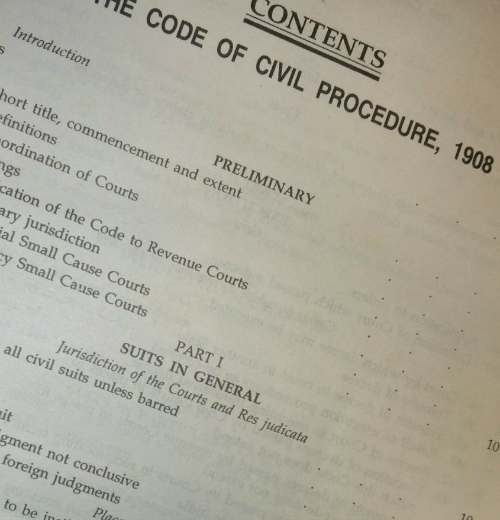 In my previous post here, I discussed a few important terms from the Code of Civil Procedure, 1908 (“CPC”). That discussion alone illustrates that mechanical compliance with procedural law is not enough. Even though they are regularly described as the handmaidens of justice, procedural legislations are also statutes to which rules of statutory interpretation apply. If you are still not convinced, just talk to some colleagues about some of the most basic terms and clauses in the CPC and you will see for yourself the varied and equally plausible interpretations they can give rise to. Imagine how much trouble the creative interpretation of procedure can cause!
In my previous post here, I discussed a few important terms from the Code of Civil Procedure, 1908 (“CPC”). That discussion alone illustrates that mechanical compliance with procedural law is not enough. Even though they are regularly described as the handmaidens of justice, procedural legislations are also statutes to which rules of statutory interpretation apply. If you are still not convinced, just talk to some colleagues about some of the most basic terms and clauses in the CPC and you will see for yourself the varied and equally plausible interpretations they can give rise to. Imagine how much trouble the creative interpretation of procedure can cause!
Let us take the case of interim applications. These are applications filed as an adjunct to the primary suit proceeding and may result in interlocutory orders, dismissals of suits, or decrees. If you represent the plaintiff, you will file along with the suit, a host of interim applications — starting from the seemingly mundane applications under Order 13 of the CPC seeking exemption from filing original documents to the important ones seeking urgent ex parte interim reliefs under Order 39 pending disposal of the suit. If you represent the defendant, you will move applications along with your written statement objecting most frequently to the maintainability of the suit on the procedural and substantive grounds under Order 7, Rules 10 and 11. Clearly, while interim applications are expected in theory to proceed in parallel to the suit, more often than not they interfere with the progress of the suit and vice versa.
More interim reliefs in the CPC, Horatio, than are dreamt of in your philosophy
Because of practice and convention, a few interim applications are invoked more often than others. But lawyers cannot afford to limit their knowledge to provisions that they frequently encounter. In fact, what better way to impress a court than to invoke a less-trod procedural provision and to explain to the court the manner in which it should be construed and applied? For instance, when sued by a foreign party that has no immovable property in India, it might help to test waters by drawing the court’s attention to Order 25 of the CPC to require the plaintiff to deposit security in court. This will help you understand the plaintiff’s will to fight to the finish since an order for depositing security casts an additional financial burden on the plaintiff besides the court fee and legal costs it has already incurred.
Another example is Order 13-A of the CPC, introduced recently through the Commercial Courts Act, 2015. It allows a defendant to seek a summary judgment in any commercial dispute if it is able to convince the court that the plaintiff is unlikely to succeed at trial and therefore no need for a protracted conventional trial. The Commercial Courts Act, 2015 is replete with such opportunities because it is designed to reduce frivolous litigation and expedite genuine litigation.
Know when to press a procedural button
That said, it is also important to appreciate the distinction between the theoretical availability of a procedural option at any stage and the appropriateness of invoking it from a strategic perspective. For instance, interrogatories under Order 11 of the CPC allow a party to put factual questions or questions relating to documents with a view to elicit answers which are not evasive. While this mechanism has certain benefits on paper, it gives the other side a peek at the interrogating party’s potential strategy at trial, besides the obvious advantage of answering questions without being under the pressure of cross-examination. Similarly, while it may seem routine to lodge a caveat under Section 148A of the CPC with a view to pre-empt the grant of ex parte orders, it is important to consider how such a course of action may be perceived and the adverse inference that a court may draw. Once again, this is a question of strategy and a litigator has to strike a balance between knowledge of a provision and the advisability of its application.
Substantive legislations also provide for a host of interim applications addressing various aspects of the subject-matter they cover. For instance, on February 5, 2016, a full bench of the Delhi High Court delivered a decision on the application of Section 124 of the Trademarks Act, 1999 under which infringement suit proceedings can be stayed subject to the satisfaction of the conditions under the provision. This decision is being considered by a division bench in a batch of appeals where Section 124 has been commonly invoked. I happen to be arguing in one of the appeals and hopefully, shall be able to write on this issue once there is more clarity.
In the next post, I will discuss discovery proceedings.
J.Sai Deepak, an engineer-turned-litigator, is an Associate Partner in the Litigation Team of NCR-based Saikrishna & Associates. Sai is @jsaideepak on Twitter and is the founder of the blawg “The Demanding Mistress” where he writes on economic laws, litigation and policy. All opinions expressed here are academic and personal.



